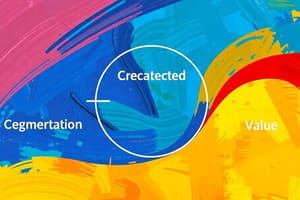Podcast
Questions and Answers
Which of the following is NOT considered a necessity in the context of disposable income?
Which of the following is NOT considered a necessity in the context of disposable income?
- Movies (correct)
- Shelter
- Clothing
- Food
What is the term used to describe an organization's commitment to maximizing its positive impact and minimizing its negative impact on society?
What is the term used to describe an organization's commitment to maximizing its positive impact and minimizing its negative impact on society?
- Self-regulation
- Marketing citizenship
- Discretionary income
- Social responsibility (correct)
Which of the following is NOT a stage of the business cycle?
Which of the following is NOT a stage of the business cycle?
- Recession
- Depression
- Inflation (correct)
- Prosperity
Which of the following is the foundation of the hierarchy of CSR?
Which of the following is the foundation of the hierarchy of CSR?
What is the role of the Federal Trade Commission (FTC)?
What is the role of the Federal Trade Commission (FTC)?
Which of the following is NOT considered an external factor that helps to form a PESTLE analysis?
Which of the following is NOT considered an external factor that helps to form a PESTLE analysis?
What kind of analysis should a company conduct to determine their position within a market?
What kind of analysis should a company conduct to determine their position within a market?
Which of the following is NOT considered a component of a SWOT analysis?
Which of the following is NOT considered a component of a SWOT analysis?
What is the purpose of a company's mission statement?
What is the purpose of a company's mission statement?
What is a core competency considered to be?
What is a core competency considered to be?
What is the difference between 'opportunities' and 'strengths' in a SWOT analysis?
What is the difference between 'opportunities' and 'strengths' in a SWOT analysis?
Which of the following is the best example of an external factor that could affect a company's marketing strategy?
Which of the following is the best example of an external factor that could affect a company's marketing strategy?
What is the primary objective of market segmentation?
What is the primary objective of market segmentation?
Which of the following is NOT a key component of a SWOT analysis?
Which of the following is NOT a key component of a SWOT analysis?
Which of the following is NOT an example of a direct competitor to Pizza Hut?
Which of the following is NOT an example of a direct competitor to Pizza Hut?
Which of the following is NOT a component of the marketing mix?
Which of the following is NOT a component of the marketing mix?
Which element of the marketing mix is considered the most flexible?
Which element of the marketing mix is considered the most flexible?
Which of the following is the best example of a competitive advantage in product?
Which of the following is the best example of a competitive advantage in product?
Which of the following is an example of a generic competitor to Diet Coke?
Which of the following is an example of a generic competitor to Diet Coke?
Which of the following is NOT a step in competitive analysis?
Which of the following is NOT a step in competitive analysis?
Which of the following is the best description of "omnichannel"?
Which of the following is the best description of "omnichannel"?
Which of the following is the best example of environmental scanning?
Which of the following is the best example of environmental scanning?
Which of the following is an example of a brand competitor to Coca-Cola?
Which of the following is an example of a brand competitor to Coca-Cola?
Which of the following is the best description of "green marketing"?
Which of the following is the best description of "green marketing"?
Which of the following is NOT a key difference between a "competitive advantage" and a "competitive analysis"?
Which of the following is NOT a key difference between a "competitive advantage" and a "competitive analysis"?
Which of the following is an example of a "total budget competitor" to Coca-Cola?
Which of the following is an example of a "total budget competitor" to Coca-Cola?
Which of the following is the best example of a "proactive" approach to environmental forces?
Which of the following is the best example of a "proactive" approach to environmental forces?
Which of the following is the best example of "digital marketing"?
Which of the following is the best example of "digital marketing"?
Flashcards
Disposable Income
Disposable Income
Income available for spending or saving after necessities are covered.
Discretionary Income
Discretionary Income
Income that is available for non-essential goods and services.
Business Cycle
Business Cycle
Fluctuations in economic activity, typically including prosperity, recession, depression, and recovery.
Federal Trade Commission (FTC)
Federal Trade Commission (FTC)
Signup and view all the flashcards
Social Responsibility
Social Responsibility
Signup and view all the flashcards
KPI (key performance indicators)
KPI (key performance indicators)
Signup and view all the flashcards
SWOT analysis
SWOT analysis
Signup and view all the flashcards
Direct competitors
Direct competitors
Signup and view all the flashcards
Indirect competitors
Indirect competitors
Signup and view all the flashcards
Marketing mix
Marketing mix
Signup and view all the flashcards
Product development
Product development
Signup and view all the flashcards
Price flexibility
Price flexibility
Signup and view all the flashcards
Place strategy
Place strategy
Signup and view all the flashcards
Promotion activities
Promotion activities
Signup and view all the flashcards
Competitive advantage
Competitive advantage
Signup and view all the flashcards
Market orientation
Market orientation
Signup and view all the flashcards
Digital marketing
Digital marketing
Signup and view all the flashcards
Environmental scanning
Environmental scanning
Signup and view all the flashcards
Brand competitors
Brand competitors
Signup and view all the flashcards
Monopoly
Monopoly
Signup and view all the flashcards
Target Market
Target Market
Signup and view all the flashcards
Marketing Strategy
Marketing Strategy
Signup and view all the flashcards
Core Competency
Core Competency
Signup and view all the flashcards
Situational Analysis
Situational Analysis
Signup and view all the flashcards
PESTLE Analysis
PESTLE Analysis
Signup and view all the flashcards
Strengths
Strengths
Signup and view all the flashcards
Weaknesses
Weaknesses
Signup and view all the flashcards
Study Notes
Marketing & Value Creation
- Customer: The purchaser of products/services; the focus of marketing efforts.
- Target Market: A specific customer group a company focuses on.
- Marketing Strategy: A company's long-term plan to deliver a unique customer experience and achieve goals.
- Exchange: The transfer of goods, services, or ideas in exchange for something of value.
- Mission Statement: A company's declaration of its purpose, value proposition, and position in the market.
- Vision Equation: Vision = Values + Competencies
- Values: Important principles guiding a company.
- Competencies: Skills and resources supporting a company's values.
- Core Competency: A unique skill or technology creating distinct customer value.
- Resources and Capabilities: Building blocks for value-added strategies.
- Situational Analysis: Understanding the current market context through PESTLE and SWOT analyses.
- PESTLE Analysis: External forces (Political, Economic, Social, Technological, Legal, Environmental).
- SWOT Analysis: Internal Strengths and Weaknesses; External Opportunities and Threats.
- Data: Crucial for understanding internal and external factors within SWOT.
- Strengths: Internal capabilities for success.
- Weaknesses: Internal limitations hindering success.
- Opportunities: External factors for advantage.
- Threats: External challenges hindering performance.
- Employees & Customers: Essential internal data sources for SWOT.
- Industry & Competitors: Key external data sources for SWOT.
- Competitive Analysis: Identifying, assessing, and selecting competitors for strategic advantage.
- Direct Competitors: Companies in the same industry (e.g., Pizza Hut vs. Domino's)
- Indirect Competitors: Companies in the same industry with substitute goods/services (e.g., Pizza Hut vs. Taco Bell)
- Marketing Mix: Product, Price, Place, Promotion.
- Product: A good, service, or idea; often needing development, modification, or elimination.
- Price: Value assigned to a product; a flexible marketing mix component.
- Place: Delivering products at the right time and location.
- Promotion: Activities persuading customers to respond favorably.
- Unmet Need: The need the company fulfills.
- Competitive Advantage (Product): Ways brands satisfy unmet needs.
- Marketing Concept: Company strategy focused on customer satisfaction.
- Market Orientation: Company commitment to research and respond to customer needs.
- Green Marketing: Long-term relationships with customers and environmental sustainability.
- Competitive Analysis Steps: Identify competitors, products, sales process, pricing, marketing, and SWOT analyses.
Digital Marketing
- Digital Marketing: Leveraging digital media for communication and exchange with customers.
- Social Media Marketing: Utilizing social media platforms to market products/brands/companies.
- Omnichannel: A multichannel approach offering a seamless customer experience across various mediums.
Marketing Environment
- Marketing Environment: Factors influencing inputs and outputs of an organization.
- Environmental Scanning: Gathering information about the marketing environment.
- Environmental Analysis: Assessing and interpreting collected information.
- Competition: Other firms offering similar or substitute products.
- Brand Competitors: Market similar products (e.g., Coke vs. Dr. Pepper).
- Product Competitors: Compete in the same product class but with different features and prices (e.g., Coke vs. flavored water).
- Generic Competitors: Offer different products to solve the same problem (Diet Coke vs. tap water).
- Total Budget Competitors: Compete for the same customer spending (Coke vs. gum/newspapers).
- Monopoly: Sole seller of a unique product.
- Oligopoly: Small number of sellers controlling a large market (Airlines).
- Monopolistic Competition: Many competitors, attempting to differentiate products (e.g., Wrangler Jeans vs. True Religion Jeans).
- Pure Competition: Very large number of sellers, none influencing prices.
- Buying Power: Resources enabling purchase (income, credit, wealth).
- Disposable Income: After-tax income; used for spending or savings.
- Discretionary Income: Income left for spending or saving after covering necessities.
- Business Cycle: Prosperity, recession, depression, recovery.
- Federal Trade Commission (FTC): Regulates business practices.
- Self-Regulation: Businesses regulating themselves to prevent government intervention.
- Social Responsibility: Maximizing positive impact and minimizing negative impact on society.
- Marketing Citizenship: Adopting and fulfilling social responsibilities.
- Corporate Social Responsibility (CSR) Hierarchy: Economic, Legal, Ethical, Philanthropic responsibilities.
Studying That Suits You
Use AI to generate personalized quizzes and flashcards to suit your learning preferences.




